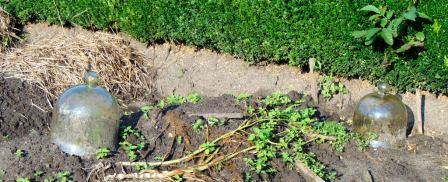To keep food from own production, there are several methods and techniques. It is convenient to harvest and process an entire production immediately all together.
But to eat fresh fruits and vegetables is not convenient if everything is equal ripe or ready to harvest at one same moment. Tomatoes, strawberries, lettuce... you’d rather eat regularly one portion, instead of 20 kilograms in 3 days. There are a number of possibilities to extend or advance the harvest season. Some of them can also be combined.
Early and late varieties
For fruit and vegetables, there are several breeds developed, adapted to latitude and climate. So it is possible to grow both early and late varieties. You can use northern (e.g. Russian) varieties. Because you often only need a few plants, you may well agree with fellow gardeners to buy together and distribute the seeds. Or who consults early with neighbors and family, who’ll plant late berries or potatoes, …. So you can share products, plenty and experience and spread your risks for related diseases and poor harvests.
Spread the sowing time
Sow preferably each 4 days some seeds (e.g. lettuce) instead of all at once.
Pre-germination
You can give some seeds a quick start by pre-germination in moist and warm (e.g. between paper towel) conditions. They'll be germinating already well and grow a few days before the on spot sown.
Tough seeds (peas, beans) can also be soaked 24 or 36 hours in a little warm water and swell. Let hatching roots not become too long, otherwise they can easily break while planting.
You can expose seed potatoes some days to light to get hefty sprouts.
An additional advantage of germinating seeds is that they are often less palatable for rivals (worms, birds), and thereby the yield can be higher.
Select a location
You can sow or plant in a shady and fresh corner of the garden, in a sheltered spot, or near a hot wall. (See also <Fruit wall>) Or in the greenhouse. That affects the growth, and therefore the harvest season. An inclined garden bed catches sun and warms up faster.
Control the climate
 You can create a microclimate to exploit protective conditions. Sowing for example, some seeds:
You can create a microclimate to exploit protective conditions. Sowing for example, some seeds:
inside on the windowsill (south, north,...)
inside on the windowsill in a transparent (cut open) PET bottle or pastry packaging
in a greenhouse or plastic tunnel
under a glass (cloches) or bell jar in the garden (you can also cover a plant with a PET bottle without bottom, or a transparent plastic bag on one (or two) sticks.)
You have to harden the plants for planting out: gradually get them used to colder temperatures.
Pots
Sow in pots and cups. That you can put inside and outside depending on the weather. You can also harden the plant before planting in open ground. If you used soil block or paper or cardboard tubes, you can plant them. And you can also leave a pot indoors or in the greenhouse.
Propagator
Is actually a mini-greenhouse. Just a wooden (or stone, metal, but wood is warmer) bucket with a glass cover on it. Sloping landscaped to maximize catch of southern sun and heat in the spring.
Hotbed
A propagator with a heat -producing layer of manure (see <Hotbed>
Agricultural film or foil
You can have a transparent plastic film over a crop area as plant or ground cover. There are also breathable, perforated films. I.a. strawberries are so early.
Warm colors
Black absorbs heat, white reflects it. So you can give some plants a different surface. You can handle plastic (like strawberries and root cloth) but also with dark compost and white sand.
Not only the temperature will be higher, but also the light output.
Keyhole Garden
The Keyhole Garden is an African system to grow vegetables in poor, dry conditions. Central is a permeable compost chimney braided with branches (1 m high). Around this comes an increased seedbed of stacked stones (or whatever you have available). From the outer ring is also a recessed narrow path into the inner ring bordered. (This, together with the compost bin forms a keyhole when viewed from above.) So the compost heap remains accessible. The entire bottom of the chimney gets a moisture permeable layer of rock (waste).
Inside are compostable waste and landfill. That decays slowly, and delivers nutrients and moisture for the plants in the raised bed. So you can still grow vegetables with little water and nutrients.
This compact garden is also somewhat resistant to flooding, and can be easily protected with a net against animals.
In our climate, the garden with built in composter also has advanteges. Anyone who has seen a compost heap fumes got it right: the compost gives off its heat to the ground, making the growing season longer.
The Zaï technique is used in poor (sandy) soils and barren desert areas. In sowing and planting pits is organic material dumped to grow plants as in pots and to provide nutrients and moisture.
